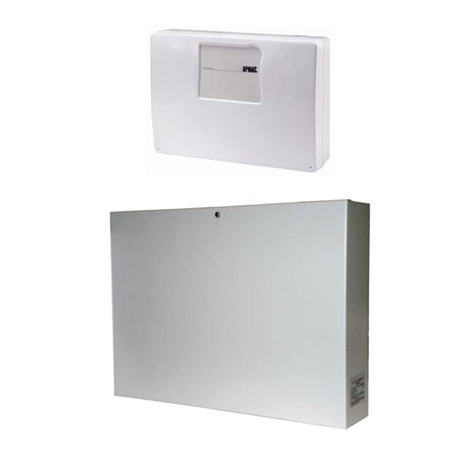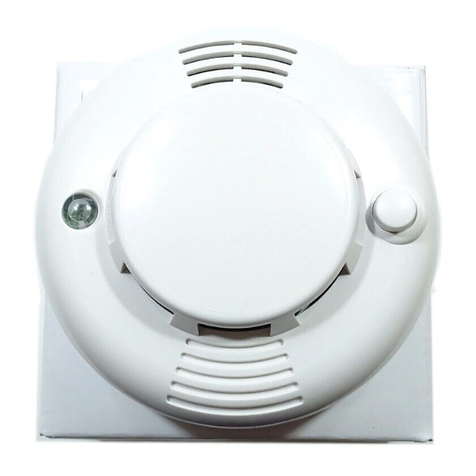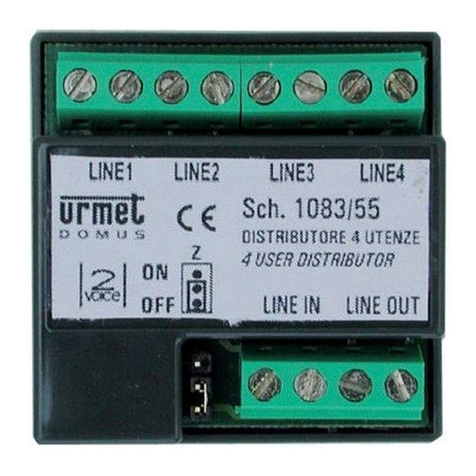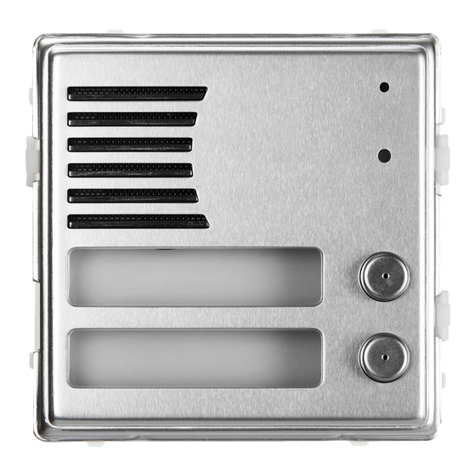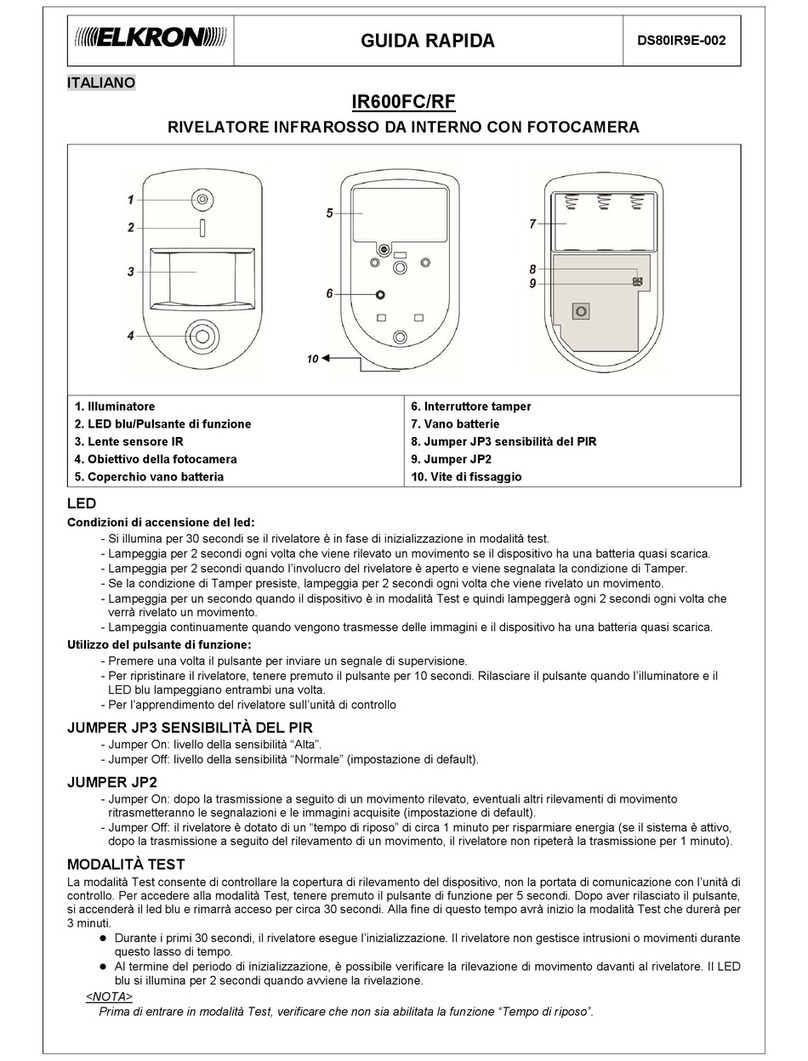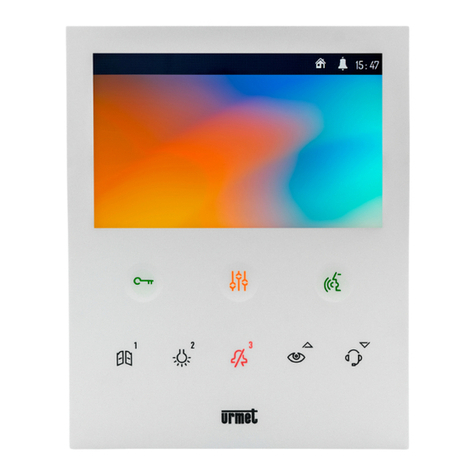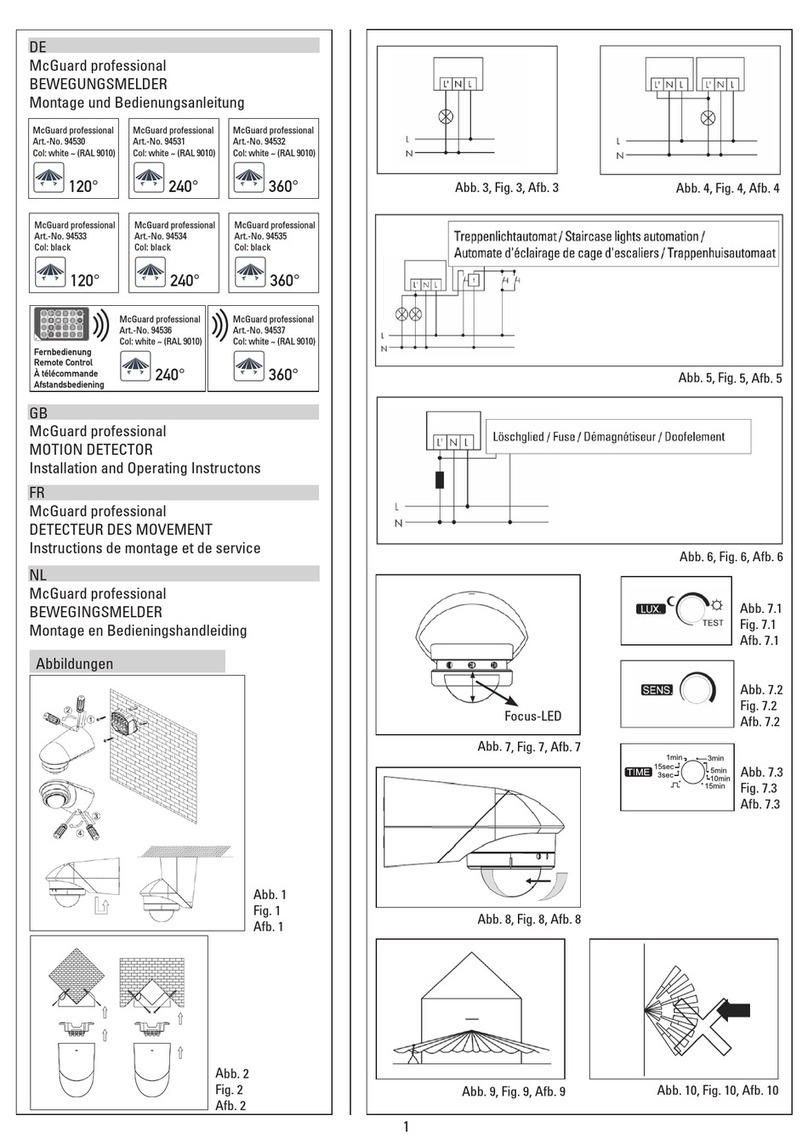
RIVELATORE INFRAROSSO
INFRARED DETECTOR
Sch./Ref. 1033/012
Copertura / Cover
CARATTERISTICHE TECNICHE
Tensione nominale di alimentazione: ...12V +/- 3V
Assorbimento a 12 V : ........................13mA nom. 17mA max
Portata: .................................................15 m
Copertura IR:.........................................90°
Zone sensibili: .......................................18 su 4 piani con creep zone
Opto Relè di allarme: ............................100mA / 24V
Tamper antimanomissione:...................100 mA / 30V
Tempo Allarme:.....................................3 sec
Temperatura di funzionamento: ............-10°C ÷ +55°C
Umidita Ambientale:..............................95%
MTBF Teorico:.......................................120.000 ORE
Dimensioni (h x l x p):............................
6 x 6 x 4,5 mm
Peso:.....................................................65 g
ACCESSORI OPZIONALI
•Snodo per rivelatori per interno sch. 1033/119
•Accessorio per Pet Immunity sch. 1033/669
AVVERTENZE
•Installare il sensore su superfici rigide, prive di vibrazioni, ad una altezza
compresa tra 2 e 2,3 metri facendo riferimento ai diagrammi di rilevazione.
•Evitare il posizionamento del sensore vicino a fonti di calore o alla luce diretta
del sole.
•Evitare che esistano, a causa di mobili, scaffalature, etc. zone cieche nell’area
protetta entro cui possa muoversi l’intruso.
•Non installare il sensore all’esterno.
•Nel caso di installazioni ad altezze superiori ai 2,2 metri si consiglia l’utilizzo
dello snodo opzionale, inclinando il sensore in modo da adattare al meglio i
campi di copertura alle effettive necessità.
INSTALLAZIONE
INSTALLAZIONE SENZA SNODO
Per rimuovere il coperchio del sensore togliere la vite di chiusura (se inserita) e
premere con un cacciavite sul dente di fissaggio, verso l’interno della feritoia.
Per togliere il circuito stampato allargare uno dei ganci E1-E2 (Fig. 2).
Fondo plastico del sensore (Fig. 2):
•A1-A2 = PREDISPOSIZIONI PER IL FISSAGGIO AD ANGOLO
•B1-B2 = PREDISPOSIZIONI PER IL FISSAGGIO SU SUPERFICIE PIANA
•C1-C2-C3 = PREDISPOSIZIONI PER IL PASSAGGIO CAVI
Fissare il fondo plastico alla parete con le viti e i tasselli, avendo cura che le
teste delle stesse non tocchino la scheda elettronica. Rimontare il circuito sul
fondo plastico.
INSTALLAZIONE CON SNODO
Per il montaggio dello snodo,
aprire le apposite predisposizioni
a sfondamento “D” (fissaggio
snodo) e “C3” (passaggio cavi
snodo) visualizzate in Fig. 2 ed
assemblare lo snodo; è
importante, terminato
l’orientamento, bloccare il movimento dello snodo serrando a fondo la vite
fornita a corredo dello stesso. Il manuale completo dello snodo è disponibile sul
sito www.urmet.com.
TECHNICAL CHARACTERISTICS
Nominal power voltage:................... 12V +/- 3V
Consumption at 12 V : .................. 13mA nom. 17mA max.
Range: ............................................ 15 m
IR coverage: .................................... 90°
Sensitive zones:............................... 18 on 4 floors with creep zone
Alarm relay opto:.............................. 100mA / 24V
Tamperproof switch:........................ 100 mA / 30V
Alarm time:....................................... 3 sec
Working temperature range:............ -10°C – +55°C
Ambient humidity:............................ 95%
Theoretical MTBF:........................... 120,000 HOURS
Dimensions (h x w x d): ................... 6 x 6 x 4,5 mm
Weight:............................................. 65 g
OPTIONAL ACCESSORIES
•Detectors brackets Ref. 1033/119
•Pet Immunity accessory Ref. 1033/669
CAUTIONS
•Install the sensor on rigid, vibration-free surfaces at a height comprised
between 2 and 2.3 metres making reference to the detection diagrams
•Avoid positioning the sensor close to sources of heat or direct sunlight.
•Avoid the creation of blind areas caused by furniture, shelving etc. in the
protected area in which an intruder could move about.
•This detector is only for indoor use
•In case of installations at heights greater than 2.2 metres, it is advisable
to use the optional bracket, including the sensor so as to adapt the
coverage fields better to the actual needs.
INSTALLATION
INSTALLATION WITHOUT BRACKET
To remove the sensor cover, remove the fastening screw (if inserted) and
press with a screwdriver on the fastening screw towards the inside of the
slot. Widen one of the hooks E1-E2 to remove the printed circuit (Fig. 2).
Warning: do not touch the pyroelectric sensor with your fingers.
Plastic bottom of the sensor (Fig. 2):
•A1-A2 = SET-UP FOR FIXING IN CORNER
•B1-B2 = SET-UP FOR FIXING ON FLAT SURFACE
•C1-C2-C3 = SET-UP FOR CABLE PASSING
Fix the plastic bottom to the wall with screws and anchor bolts being careful
that they do not touch the electronic board. Refit the circuit onto the plastic
bottom.
INSTALLATION WITH BRACKET
To install the bracket, open
the specific cut-out areas "D"
(bracket fastening) and "C3"
(bracket cable passage)
shown in Fig. 2, and
assemble the bracket.
Importantly, after orienting,
block the movement of the bracket by tightening the screw provided with the
bracket. The complete user manual of the bracket is available on the
website www.urmet.com.
GB
LBT20174
DS1033-141
Fig. 1 Fig. 2
I


